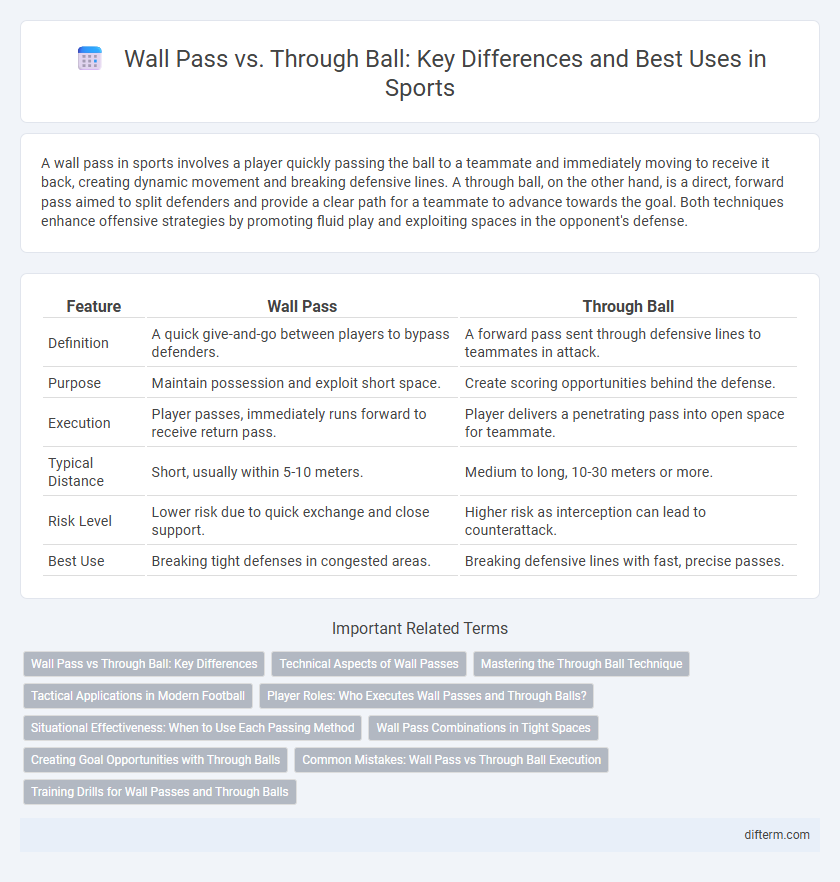A wall pass in sports involves a player quickly passing the ball to a teammate and immediately moving to receive it back, creating dynamic movement and breaking defensive lines. A through ball, on the other hand, is a direct, forward pass aimed to split defenders and provide a clear path for a teammate to advance towards the goal. Both techniques enhance offensive strategies by promoting fluid play and exploiting spaces in the opponent's defense.
Table of Comparison
| Feature | Wall Pass | Through Ball |
|---|---|---|
| Definition | A quick give-and-go between players to bypass defenders. | A forward pass sent through defensive lines to teammates in attack. |
| Purpose | Maintain possession and exploit short space. | Create scoring opportunities behind the defense. |
| Execution | Player passes, immediately runs forward to receive return pass. | Player delivers a penetrating pass into open space for teammate. |
| Typical Distance | Short, usually within 5-10 meters. | Medium to long, 10-30 meters or more. |
| Risk Level | Lower risk due to quick exchange and close support. | Higher risk as interception can lead to counterattack. |
| Best Use | Breaking tight defenses in congested areas. | Breaking defensive lines with fast, precise passes. |
Wall Pass vs Through Ball: Key Differences
Wall pass involves a quick one-two exchange between two players to bypass an opponent, creating immediate space and maintaining close control. A through ball is a forward pass that penetrates the opponent's defensive line, aiming to set a teammate free for a scoring opportunity. While the wall pass emphasizes coordination and speed in tight areas, the through ball focuses on vision and timing to exploit defensive gaps.
Technical Aspects of Wall Passes
Wall passes rely on precise timing and close-range accuracy, requiring players to execute quick, one-touch passes off a teammate to bypass defenders. The technical aspects emphasize sharp angle control and spatial awareness to maintain momentum and create immediate scoring opportunities. Mastery of body positioning and the ability to anticipate the teammate's movement are crucial for effective wall pass execution.
Mastering the Through Ball Technique
Mastering the through ball technique involves precise timing and accurate weight of the pass to split defenses and create clear goal-scoring opportunities. Unlike a wall pass, which relies on immediate player interplay to bypass an opponent, the through ball requires anticipation of teammates' runs and spatial awareness to exploit gaps in the defensive line. Elite footballers use through balls to accelerate attacking plays and maintain fluidity in offensive transitions.
Tactical Applications in Modern Football
Wall passes facilitate quick, short exchanges between teammates to bypass defenders and create immediate attacking opportunities, often used in tight spaces to maintain possession and disrupt defensive lines. Through balls are strategically threaded passes that exploit gaps behind the opposition's defense, enabling forwards to run onto the ball and increase goal-scoring chances by stretching defensive formations. Both tactics emphasize spatial awareness and timing but differ in execution; wall passes rely on rapid combination play while through balls prioritize vision and precision for penetrating passes.
Player Roles: Who Executes Wall Passes and Through Balls?
Wall passes are predominantly executed by midfielders and forwards who operate in tight spaces, utilizing quick, short exchanges to break defensive lines. Through balls are typically played by attacking midfielders and wingers, aiming to exploit gaps behind defenders with precise, forward-driven passes. Defenders occasionally deliver through balls to launch counterattacks, but wall passes demand close coordination between players with sharp spatial awareness and quick decision-making.
Situational Effectiveness: When to Use Each Passing Method
Wall passes excel in tight spaces near the penalty area, enabling quick one-two exchanges that disrupt defensive lines and create immediate scoring opportunities. Through balls are most effective in open-field situations, threading the ball between defenders to exploit gaps and launch fast breaks behind the defensive line. Choosing between these passing methods depends on the proximity of defenders and the speed of the attacking play to maximize offensive advantage.
Wall Pass Combinations in Tight Spaces
Wall pass combinations excel in tight spaces by enabling quick, precise one-two exchanges that bypass defenders and maintain team momentum. This technique leverages close player coordination and sharp timing to create scoring opportunities in congested areas, often leading to breakaways or shots on goal. Mastery of wall passes enhances spatial awareness and ball control, making it invaluable for unlocking stubborn defenses.
Creating Goal Opportunities with Through Balls
Through balls create goal opportunities by splitting the defense with precise, timed passes that allow attackers to run onto the ball in dangerous positions. Unlike wall passes, which rely on immediate one-two interactions to bypass defenders, through balls exploit gaps in defensive lines, enhancing the likelihood of a clear shot on goal. Effective through balls require vision, accuracy, and anticipation to unlock tight defenses and generate high-quality scoring chances.
Common Mistakes: Wall Pass vs Through Ball Execution
Common mistakes in executing a wall pass include poor timing and inaccurate touch, which can disrupt the fluidity of play and lead to turnovers. In contrast, through ball errors often stem from misjudging defensive positioning and insufficient pace, causing the pass to be intercepted or easily cleared. Mastering spatial awareness and communication significantly reduces these errors, enhancing overall team dynamics in attacking scenarios.
Training Drills for Wall Passes and Through Balls
Effective training drills for wall passes emphasize quick one-touch exchanges, using cones or markers to simulate wall players, enhancing timing and spatial awareness. Through ball drills focus on precision and timing by practicing penetrating passes behind defensive lines, often using mannequins or defenders to replicate match scenarios. Incorporating both sets of drills improves player coordination, decision-making, and attacking fluidity in competitive matches.
wall pass vs through ball Infographic

 difterm.com
difterm.com